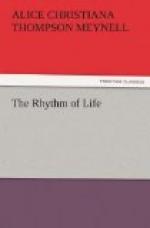Humour is the most conspicuous thing in the world, which must explain why the little humour in Elsie Venner and the Breakfast Table series is not only the first thing the critic touches but the thing whereby he relates this author to his following and to the world. The young man John, Colonel Sprowle with his ‘social entertainment,’ the Landlady and her daughter, and the Poor Relation, almost make up the sum of the comic personages, and fifty per cent. of the things they say—no more—are good enough to remain after the bloom of their vulgarity has worn off. But that half is excellent, keen, jolly, temperate; and because of that temperance—the most stimulating and fecundating of qualities—the humour of it has set the literature of a hemisphere to the tune of mirth. Like Mr. Lowell’s it was humour in dialect—not Irish dialect nor negro, but American; and it made New England aware of her comedy. Until then she had felt within herself that there was nothing to laugh at. ’Nature is in earnest when she makes a woman,’ says Dr. Oliver Wendell Holmes. Rather, she takes herself seriously when she makes the average spiritual woman: as seriously as that woman takes herself when she makes a novel. And in a like mood Nature made New England and endowed her with purpose, with mortuary frivolities, with long views, with energetic provincialism.
If we remember best The Wonderful One-Hoss Shay, we do so in spite of the religious and pathetic motive of the greater part of Dr. Holmes’s work, and of his fancy, which should be at least as conspicuous as his humour. It is fancy rather than imagination; but it is more perfect, more definite, more fit, than the larger art of imagery, which is apt to be vague, because it is intellectual and adult. No grown man makes quite so definite mental images as does a child; when the mind ages it thinks stronger thoughts in vaguer pictures. The young mind of Dr. Holmes




